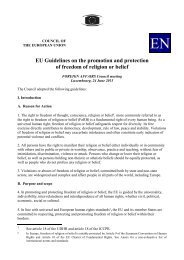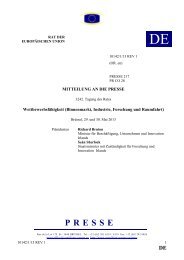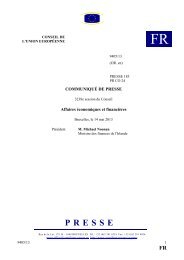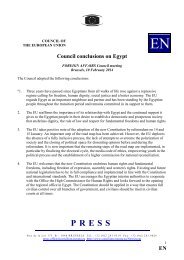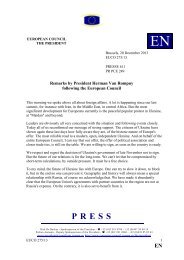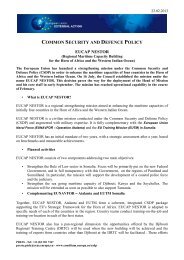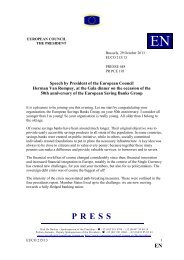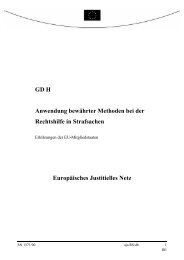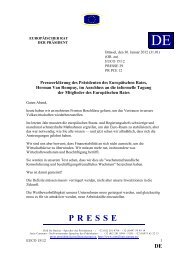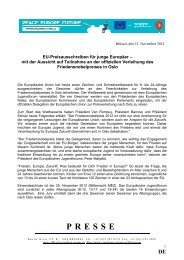14508/09 ADD 1 PL/vk 1 DG G COUNCIL OF THE ... - Europa
14508/09 ADD 1 PL/vk 1 DG G COUNCIL OF THE ... - Europa
14508/09 ADD 1 PL/vk 1 DG G COUNCIL OF THE ... - Europa
You also want an ePaper? Increase the reach of your titles
YUMPU automatically turns print PDFs into web optimized ePapers that Google loves.
At the Barcelona summit in 2002 childcare targets were set. Member States should strive to provide<br />
childcare by 2010 for at least 90 % of all children between 3 years old and compulsory school age<br />
and at least 33 % of all children below 3 years of age.<br />
Available, accessible, affordable and high-quality childcare is extremely important for working<br />
parents. Throughout EU the availability of childcare varies widely. Data indicate that some<br />
countries have widespread formal childcare arrangements, whereas others rely on more informal<br />
arrangements such as childminders, family, friends and neighbours. In the age category 0-2 years<br />
old, the use of formal childcare arrangements varies from 73 % in Denmark to 2 % in Poland and<br />
the Czech Republic. It appears that nine MS have met the Barcelona target of at least 33 % of<br />
children under 3 years of age in childcare (see figure 4.6.3). One problem is that it is not known to<br />
what extent formal childcare arrangements are compatible with both parents working. In the<br />
Netherlands and the UK, for example, a very large proportion of the children in formal childcare<br />
attend less than 30 hours per week, while in Denmark and Portugal a very large majority of children<br />
are in formal childcare for 30 hours or more. In some countries other arrangements for childcare are<br />
more common than formal childcare in this age group (see figure 4.6.4). If the proportion of<br />
children in formal and other arrangements and children only cared for by the parents are added<br />
together, the proportion in some countries amounts to more than 100 %, which indicates that<br />
parents in some countries have to rely on more than one form of childcare. It must be pointed out<br />
that the different parental leave schemes in the MS must be taken into consideration when the<br />
information in figures 4.6.3 and 4.6.4 is interpreted.<br />
The availability of formal care arrangements increases with the age of children. Within the age<br />
category 3 years old to compulsory school age, Belgium ranks highest with a use of formal<br />
childcare of almost 100 % (see figure 4.6.5). At the other end is Poland with 28 %. According to the<br />
Barcelona target the actual coverage rate should be at least 90 % in 2010. It seems as if eight MS<br />
meet the Barcelona target and two are very close. When these figures are interpreted, it has to be<br />
taken into account that in most countries pre-school is only part-time, which means that working<br />
parents still need additional childcare facilities which may be much less readily available and that<br />
children have to be moved from one place to another. In many countries, furthermore, a majority of<br />
the children in this group are in formal childcare for less than 30 hours. This indicates that the<br />
mothers are not working full-time.<br />
<strong>14508</strong>/<strong>09</strong> <strong>ADD</strong> 1 <strong>PL</strong>/<strong>vk</strong> 88<br />
ANNEX <strong>DG</strong> G EN



